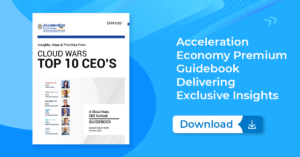Starting with the papyrus thousands of years ago, more accessible and more portable ways to store data have been under development constantly.
The cloud is the newest in a long line of destinations for data. Storing data and applications in the cloud is also an excellent way to support today’s remote work scenarios, not to mention global projects.
Migrating data to the cloud is a relatively new strategy for healthcare businesses, which also makes it a new activity for the chief procurement officer (CPO) in this industry. But a savvy CPO can apply the same processes used to acquire other complex services to help the business make decisions on selecting cloud providers and related cloud migration decisions, while factoring in specific considerations that are unique to the cloud and to the healthcare industry.
However, because it’s not solely about migration to a new supplier, cloud service acquisition in the healthcare context can be a complex sourcing activity. In this analysis, I’ll walk through several of the sourcing decisions that need to be made and make recommendations on how to approach them.
Define and Align Requirements
Clear requirements are the foundation for making the best cloud provider choice. Part of this entails the CPO helping the business get aligned on goals. Is this being done to reduce infrastructure costs, improve scalability, repurpose real estate, support global collaboration, and/or reassign headcount? The core objectives must be determined and discussed with the procurement team.
The overall business strategy determines the best cloud option among public cloud, private cloud, hybrid cloud or multi-cloud. In a project that I worked on for a global bio-pharma organization, the decision was made to move all operational and administrative applications to a public cloud, but to keep everything regarding drug development on a private cloud. This hybrid model helped calm the fears of business leaders who wanted to retain tight ownership and governance of any data or application related to new product development.
Given the level of government regulation in the healthcare industry, and the sensitive nature of patient data, it’s important to identify security protocols and compliance requirements, such as those defined under HIPAA. Also, many healthcare companies operate 24/7, 365 days a year, so uptime and availability to support this requirement must be clearly defined.
Identify and Vet Potential Cloud Providers
Not all cloud providers are created equal. Adobe Creative Cloud, for example, contains a suite of creative tools that are likely not relevant to a healthcare company. But others have products and services targeted specifically at healthcare. Amazon Web Services (AWS), Microsoft Azure, Salesforce Health Cloud, Google Cloud Platform, Oracle, IBM, and others all have healthcare-specific software and services; that’s a substantial list of suppliers to investigate.
Ensure Contracts Include an Exit Plan
A mentor from my days at Johnson & Johnson always urged us to “Negotiate the hard stuff first.” And in a cloud agreement, “the hard stuff” includes a solid, clearly defined exit plan.
The CPO must ensure it’s clear what happens at the end of the agreement. The more data that’s in a particular cloud, the harder it is to switch if the company decides to go in a different direction in the future. So the CPO can help by ensuring that the contract has the right provisions and spells out roles and responsibilities, such as who will bear the cost of switching if a decision gets made to do so. Of course, clearly defining data ownership is another top priority.
And since competitors are likely sharing the same cloud, it’s important that data protection and security measures be clearly documented and reviewed. As previously mentioned, this is particularly important in an industry such as healthcare, with its need to create, store, and access confidential patient medical records.
Identify and Vet Transition Suppliers
When migrating to the cloud, companies will discover that there are more suppliers required than might be evident at first glance. The transition requires handoffs between multiple functions, and it’s unlikely that there is adequate expertise and headcount internally, so the CPO and team will have a lot of temporary suppliers to engage and manage for services including:
- Discovery, which entails identifying what applications are running and then working with the business to confirm what is needed post-move
- Identifying interdependencies and timelines
- Identifying applications that can be retired
- Analyzing and identifying optimization opportunities
- Migration planning and support
- Data migration itself, including testing and validation
- Physical renovation of the data center post-move if the space is being repurposed
It’s easy for a company to lose sight of the many moving parts and thereby incur cost overruns. Vendor management, including regular communication and reporting, is important to avoid overruns and to ensure that everyone is executing the same gameplan. It’s necessary to understand what the business is actually running, perform any necessary “de-tangling” and move ahead judiciously to avoid downtime and significant increases in cost.

Which companies are the most important vendors in data? Check out the Acceleration Economy Data Modernization Top 10 Shortlist.
Manage Cost Saving Expectations
Cost reduction is the sweet spot for many CPOs, but it’s a difficult one to lock down when you’re operating in the cloud. In a majority of surveys, most businesses find that their cloud costs are higher than anticipated. This doesn’t mean that cloud migration isn’t a good idea or doesn’t reduce costs in certain ways; it just means that the operating costs can be a surprise.
Pinterest, for example, reportedly found that its Year One fees in the cloud were $20 million higher than anticipated because the image-sharing social media service had failed to accommodate for the demand surge around the holidays.
In healthcare, end-of-year deadlines are likely to spur a demand surge as people seek to use up funds in their health savings accounts. In addition, fee structures are complicated and healthcare businesses may not have the hard data needed to calculate anticipated costs. Vendor management plays a part here: cloud providers can advise on how to adapt to optimize cloud costs initially, then provide reporting regularly to help healthcare businesses tweak their processes going forward.
Final Thoughts
Leadership guru Mike Robbins advises clients to “keep their head in the clouds and their feet on the ground.” That’s also a good motto for a procurement team managing a healthcare cloud migration. Although it may be a new function to support, cloud migration will run more smoothly when it leverages classic procurement blocking-and-tackling techniques with which CPOs have so much expertise already.
Want more tech insights for the top execs? Visit the Leadership channel:











